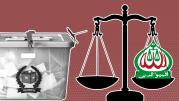An effect of Bangladesh's first-past-the-post (FPTP) electoral system is that it expands seat counts for major parties while marginalising smaller rivals.
The party with more votes than any other is elected, even if they do not have a majority of votes.
As everything in Bangladesh politics seems up in the air following the Awami League regime's ouster in August 2024, this apparent imbalance in the FPTP is fuelling renewed calls for electoral reform ahead of the upcoming election in February.
Why it matters
- Under the current first-past-the-post (FPTP) system, the candidate with the most votes in each constituency wins, often resulting in a parliament that doesn't proportionally reflect national vote shares.
- Parties like Jamaat-e-Islami, Islami Andolan Bangladesh (IAB), and the National Citizens' Party (NCP) increasingly advocate switching to Proportional Representation (PR), which allocates seats based on nationwide vote percentage.

Countries like Bangladesh, India, or the United Kingdom follow the "first-past-the-post" system. In this model, the country is divided into parliamentary constituencies.
Driving the news
- Recent 2026 election surveys highlight ongoing relevance.
- A SHUJAN survey of nearly 1,400 individuals found that 71% favour the PR system in the upper house of parliament.
- SANEM projects BNP could wn 117–118 seats, Jamaat 64–65 seats, and NCP about 48 seats under PR.
- A study by the BRAC Institute of Governance and Development (BIGD) and Voice for Reform forecasts a fragmented parliament: "Others" might hold 225 seats, BNP about 36, Jamaat roughly 31, and NCP around 8.
The big picture: How past elections would look under a PR system
1996:
- Awami League (AL) won 146 seats with 37.4% of the vote. Under the PR system, it would have gotten ~112 seats.
- Jamaat-e-Islami, with 8.6%, won 3 seats, but would have seen its share rise to around 26 under the PR system.
- Similarly, IAB, with around 1% vote share, won no seats, but would have secured around 3 under their preferred method.
2001:
- BNP won 193 seats with 41.97% of votes, while Awami League got only 62 seats despite having 40.13% of votes.
- Under a PR system, both would have around 123 seats.
- Jamaat secured 17 seats (via alliances) with 4.28% votes, but would get around 13.
- IAB (around 0.5%) would have gained some representation under PR.
2008:
- Awami League dominated with 230 seats on 48%.
- BNP won 114 seats with 39.4%.
- In a PR system, those would be adjusted to around 144 and 118 seats respectively.
- Jamaat (4.7%) won 2 seats but could have had around 14.
- IAB (around 1%) got no seats at the table but would have had 3.
The bottom line:
Historical trends and future projections show smaller parties like Jamaat, IAB, and NCP support PR for fairer parliamentary representation, reflecting actual voter support, challenging the disproportionate power of the larger political parties under the current system.
However, given the BNP's consistent opposition to PR, which it argues would hinder the formation of strong, stable governments, there seems to be no resolution on the horizon.
BNP acting chairperson Tareque Zia took things one step further, saying, "We must consider whether the PR system would inadvertently pave the way for the return of discredited fascist forces to politics."



Comments